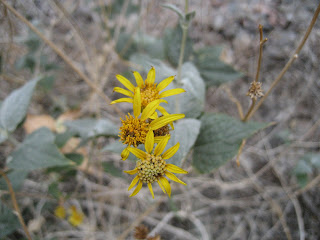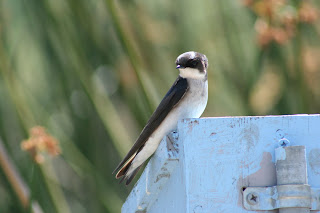
Today my California Wildlife & Places class taught by Bob Allen at IVC had a field trip up Silverado Canyon. We had a great time driving our way slowly up the winding canyon road stopping to observe the different plant species and the change in habitats as we rose in elevation.
Blue Dicks

Our first stop was to look at the riparian habitat near the road, we examined the difference between north-facing slopes and south-facing slopes, looking at the type of vegetation that grew on each, and why. We looked at coast live oaks, big leaf maples, western sycamores, and a tiny wasp that landed on my hand! We saw a warbling vireo, heard and saw a gorgeous male yellow warbler, and were treated to a black-throated gray warbler that paused for a moment to forage overhead.
Felt Paintbrush

From there we continued up and came to a bend where the first larger trees, Douglass Firs were growing. We examined the cones of the douglass firs in comparison to those of the coulter pine (often nicknamed the "widow-maker due to it's viciously large spined cones). We looked at a tiny dandelion, some hoary-leafed ceanothus, and heard a cooper's hawk calling off in the distance. Band-tailed pigeons flew past us as we stood examining plants.
Mountain Dandelion

Douglas Fir Cone

Sugar Bush

We stopped at a smal stream area, which was far colder than where we were before. Here we looked at coastal wood ferns growing beneath some interior live oaks. We saw an adorable flower called chaparral pea, and talked about the native thistle growing that is a favorite of our state butterfly, the California dogface.
Chaparral Pea

Bush Poppy

When we reached the ridgeline, we got out and walked around, looking at the few wildflowers growing, such as miniature lupins, and yellow violets. We saw red-skinned onion, which was growing in small bunches and smelled strong.
Miniature Lupin

A gorgeous male Anna's hummingbird sat quietly on a branch of mountain mohogany giving us great looks as he sat, feathers ruffled to keep warm against the fog that had rolled up the hillside.
Anna's Hummingbird

Mountain Mohogany

Yellow Violet

On our way back down the canyon, we stopped to examine an oak we had discussed at great length in class, it's called the oracle oak, and is a hybrid between black oak and interior live oak. It has traits of both. Normally this would just be a cool and somewhat expected occurance, but it happens that we don't have black oaks in our local mountains, so then how did the pollen of black oaks come to mix with the live oaks in that spot to create the hybrid? Bob's theory is that we do have black oaks in the canyons, but that they're probably in an area that is just not accessible so we don't know of their presence yet. Interesting huh?
California Gooseberry

Just for fun, my absolute favorite flower ever, our state flower.
California Poppy





















































